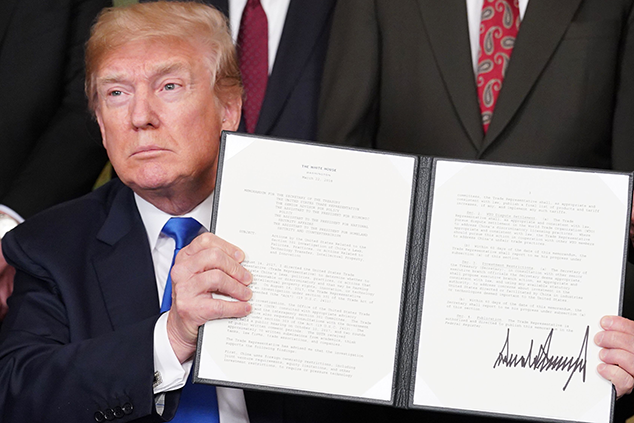
This article is taken from our FREE daily investment email Money Morning.
Every day, MoneyWeek’s executive editor John Stepek and guest contributors explain how current economic and political developments are affecting the markets and your wealth, and give you pointers on how you can profit.
.
In this week’s issue of MoneyWeek magazine
● The star fund managers who fell to earth
● How to spot tomorrow’s big stocks today
● Investing in whisky: liquid profits on the blockchain
● Aviva’s unethical hunt for a loophole in its preference shares
● Shareholders: reclaim your voting rights
● Share tips of the week
The market may finally be getting what it really needs. A good old-fashioned proper sell-off.
Yesterday the S&P 500 fell by 2.5%. The market is now in the red for 2018.
It’s not enough, but it’s a start.
Markets had been getting too complacent. When the bets all start to stack up on one side, it’s unhealthy. Investors will put up with anything, believe anything, buy anything.
Goodness, they’ll even approve an executive compensation package that could award Tesla boss Elon Musk a £40bn bonus, as long as he builds the company into a $650bn behemoth over the next decade.
That’s no way to allocate resources efficiently. So a wee reality check is not such a bad thing.
Trouble is, things might get a fair bit worse before they get better. Because it appears that we are embarking on a global trade war.
Donald Trump is a rare politician – he keeps his promises
It turns out that when Donald Trump says extremely unorthodox things, it’s not part of some grand cunning scheme to disorient his opponents. He just really means them.
Investors are really starting to wake up to that now. And it’s not coming as a pleasant surprise.
Yesterday, Trump imposed tariffs on up to $60bn of Chinese imports. His stated goal is to slash the US’s $375bn trade deficit with China, and also to protect US intellectual property. We don’t yet know which specific products will be hit with the tariffs of 25% – that’ll become clearer in the next fortnight.
Today, China has announced plans to impose tariffs on 128 US products – $3bn worth of imports. That includes tariffs on steel pipes, fruit and wine, and pork.
Being fed up with China’s tendency to strong-arm or simply steal intellectual property from foreign companies is not unreasonable. But going about challenging it in this way is certainly disruptive, and quite possibly counter-productive.
As a result, a sell-off that began yesterday in the US – led by big plays on global trade and openness, such as Caterpillar and Boeing – has continued in Asia this morning, with markets from China to Japan sliding hard. Meanwhile, the Japanese yen – a classic “safe haven” (for some reason) – strengthened against the dollar.
None of this was helped by growing political uncertainty. On the same day, Trump replaced his national security adviser with John Bolton. I have little interest in local politics in America, but to cut a long story short, Bolton is “a foreign policy hawk”, as the FT puts it.
In other words, on the same day that we inched closer to a global trade war, Trump also promoted someone who isn’t averse to backing actual wars. As Democrat Chuck Schumer put it: “Mr Bolton’s tendency to try to solve every geopolitical problem with the American military first is a troubling one.”
The real problem – markets are expensive
These measures themselves are not necessarily a big deal. As Andrew Hunter of Capital Economics points out, even if these tariffs aren’t watered down (and he thinks they will be) the overall economic impact would not be that great.
“They would cover less than 3% of total goods imports, little more than the initial scope of the recent steel and aluminium tariffs,” notes Hunter.
However, the risk of retaliation is a bigger worry. Trump may drop the tariffs out of fear that the Chinese will target farm belt states – a key constituency in the US. But if not, we could end up seeing a more extensive trade war.
In any case, as we’ve discussed before, growing protectionism is inflationary and is also likely to slow global growth. That’s all bad for profits, and thus for markets.
But the bigger problem is that markets – in the US in particular – are expensive and have been for a long time. This is always worth remembering. When markets are cheap, they can handle bad news, because it’s already in the price.
But when markets are expensive, their only real defence is to screen out reality (which is exactly what investors have been doing) until something forces them to wake up. As a result, when the wake-up call comes, it can be pretty brutal.
So what does it all mean for your investments? As I’ve said before on many occasions, the main thing is to avoid taking evasive, hasty action. This correction has been brewing for a long time, and I’d be surprised if it blows over any time soon.
The market has felt wobbly for a while, ever since the big volatility crash earlier in the year. It needs a good shakeout. Whether that turns into something bigger or not depends on which narrative investors decide to take away from all this.
However, it does increasingly look as though the “storm in a teacup” story is no longer an option.